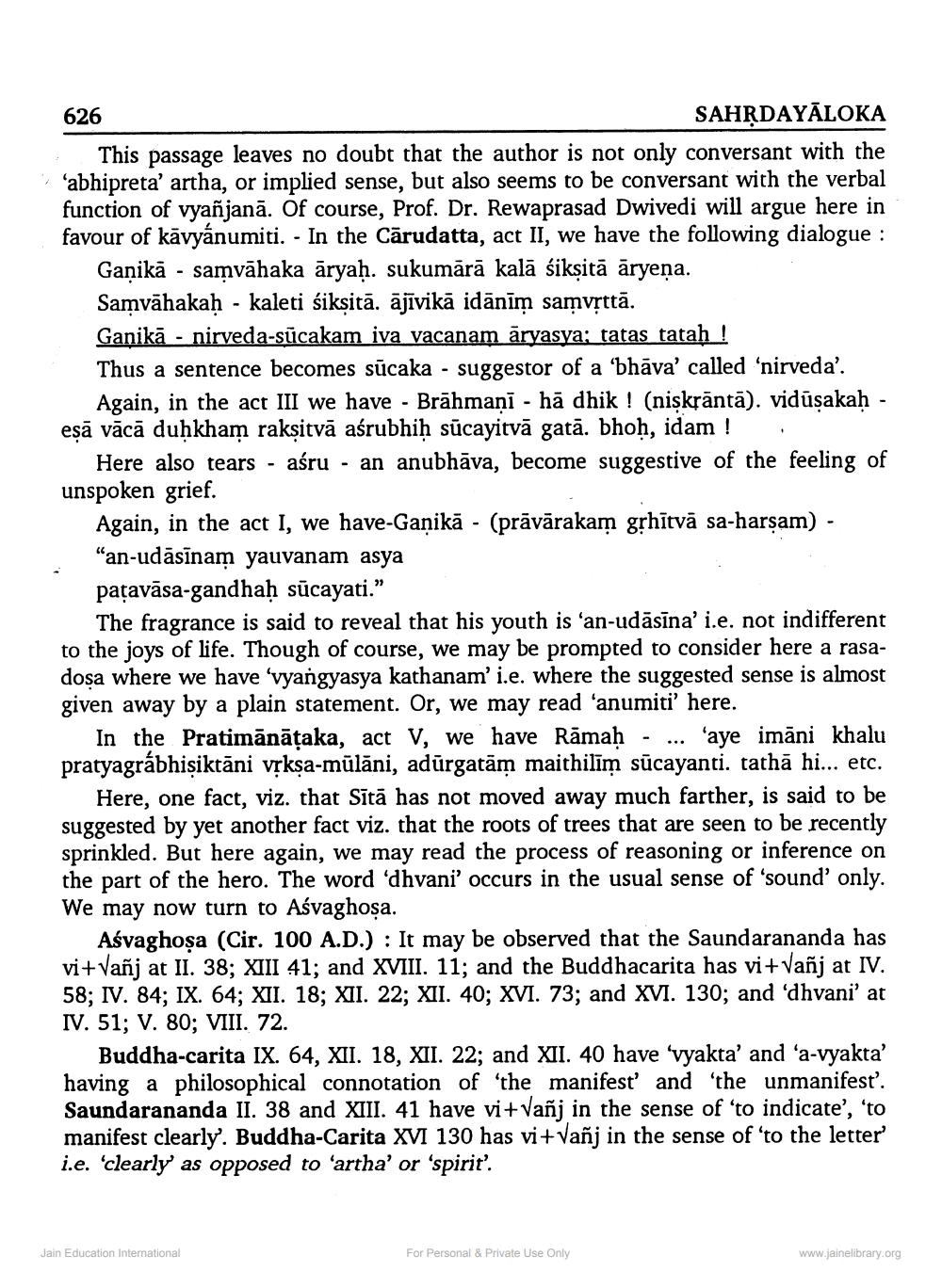________________
626
SAHRDAYĀLOKA
This passage leaves no doubt that the author is not only conversant with the abhipreta' artha, or implied sense, but also seems to be conversant with the verbal function of vyañjanā. Of course, Prof. Dr. Rewaprasad Dwivedi will argue here in favour of kāvyánumiti. - In the Cārudatta, act II, we have the following dialogue :
Ganikā - samvāhaka āryaḥ. sukumārā kalā śikṣitā āryeņa. Samvāhakaḥ - kaleti śikṣitā. ājīvikā idānīm samvịttā. Ganikā - nirveda-sūcakam iva vacanam āryasya; tatas tatah ! Thus a sentence becomes sūcaka - suggestor of a 'bhāva' called 'nirveda'.
Again, in the act III we have - Brāhmani - ha dhik ! (niskrāntā). vidūsakah - eșā vācā duḥkham rakṣitvā aśrubhiḥ sūcayitvā gatā. bhoh, idam! .
Here also tears - aśru - an anubhāva, become suggestive of the feeling of unspoken grief.
Again, in the act I, we have-Gaņikā - (prāvārakam gļhītvā sa-harşam) - "an-udāsīnam yauvanam asya patavāsa-gandhaḥ sūcayati.”
The fragrance is said to reveal that his youth is 'an-udāsīna' i.e. not indifferent to the joys of life. Though of course, we may be prompted to consider here a rasadosa where we have 'vyangyasya kathanam' i.e. where the suggested sense is almost given away by a plain statement. Or, we may read 'anumiti' here.
In the Pratimānātaka, act V, we have Rāmah - ... 'aye imani khalu pratyagrābhișiktāni vřksa-mülāni, adurgatām maithilīm sūcayanti. tathā hi... etc.
Here, one fact, viz. that Sītā has not moved away much farther, is said to be suggested by yet another fact viz. that the roots of trees that are seen to be recently sprinkled. But here again, we may read the process of reasoning or inference on
of the hero. The word 'dhvani' occurs in the usual sense of 'sound' only. We may now turn to Aśvaghosa.
Asvaghosa (Cir. 100 A.D.) : It may be observed that the Saundarananda has vi+ Vañj at II. 38; XIII 41; and XVIII. 11; and the Buddhacarita has vi+ Vañj at IV. 58; IV. 84; IX. 64; XII. 18; XII. 22; XII. 40; XVI. 73; and XVI. 130; and 'dhvani' at IV. 51; V. 80; VIII. 72.
Buddha-carita IX. 64, XII. 18, XII. 22; and XII. 40 have 'vyakta' and 'a-vyakta' having a philosophical connotation of the manifest' and 'the unmanifest'. Saundarananda II. 38 and XIII. 41 have vi+ Vañj in the sense of 'to indicate', 'to manifest clearly. Buddha-Carita XVI 130 has vi+ Vañj in the sense of 'to the letter i.e. clearly as opposed to 'artha' or 'spirit'.
Jain Education International
For Personal & Private Use Only
www.jainelibrary.org




